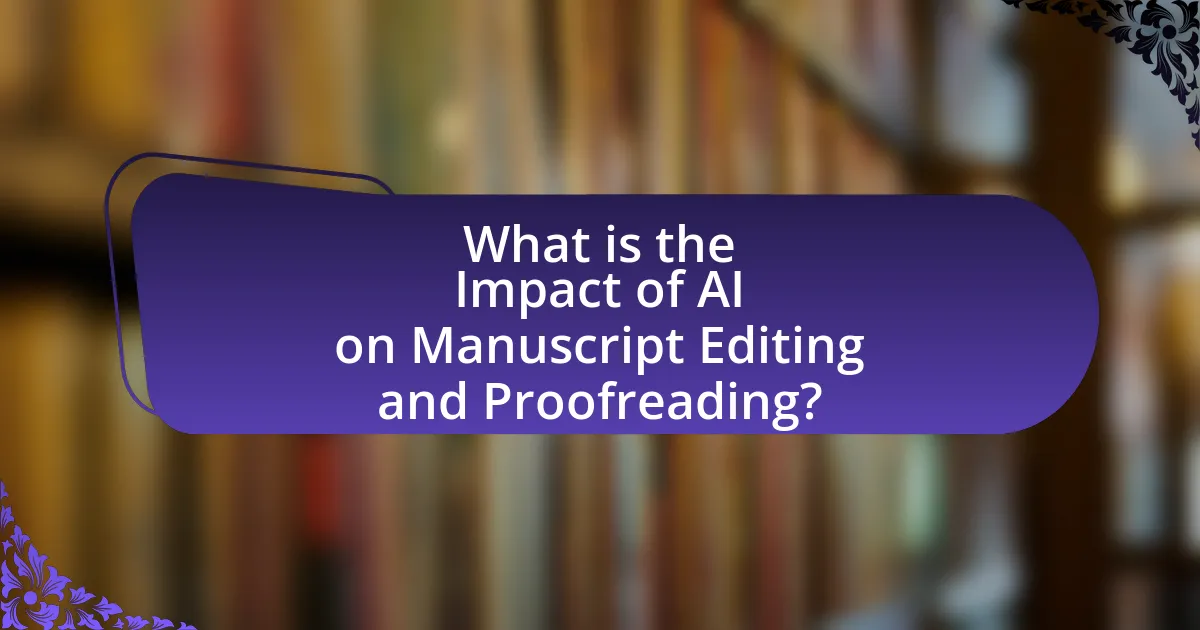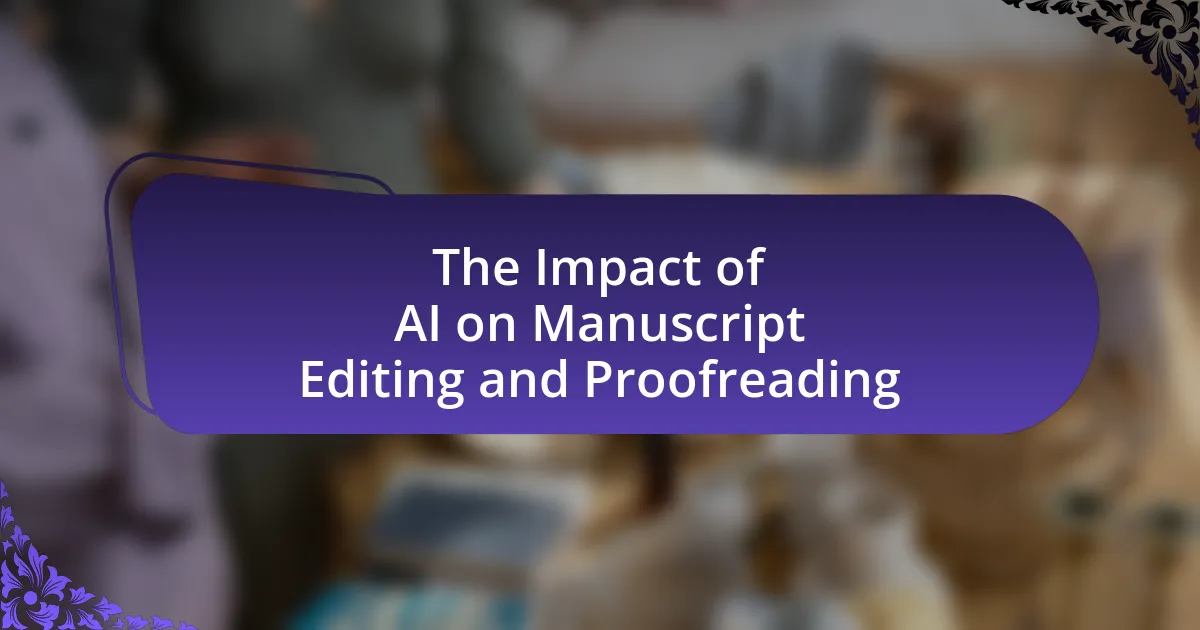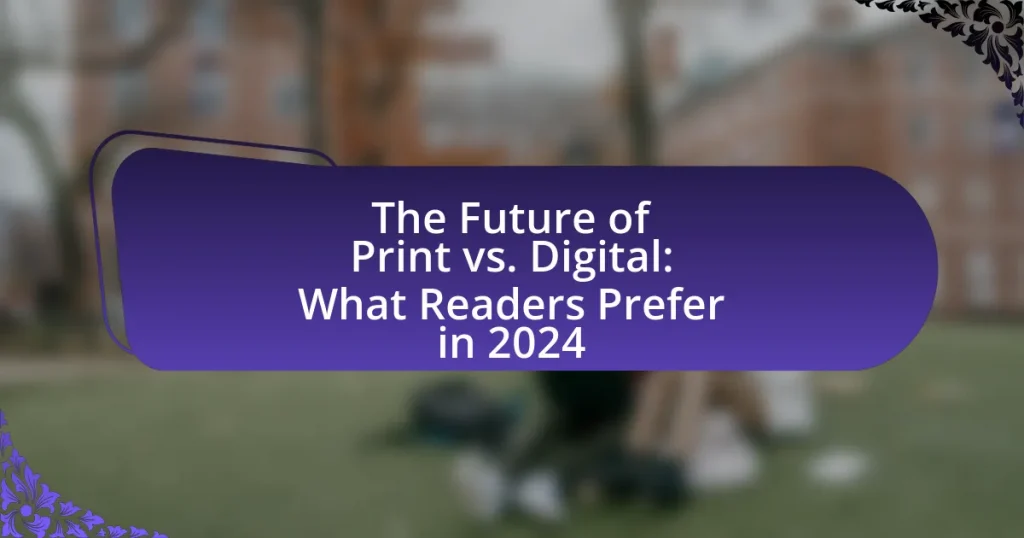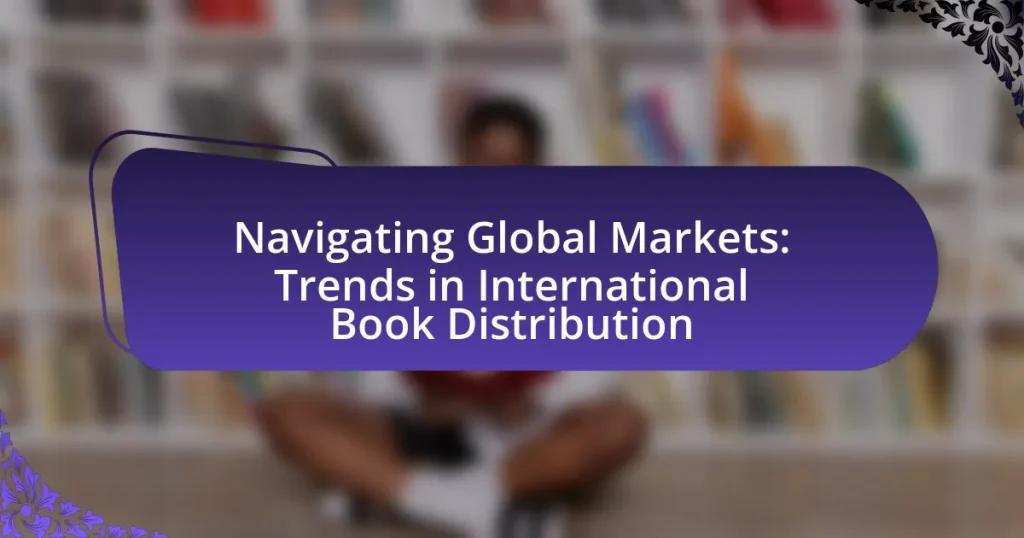The article examines the significant impact of artificial intelligence (AI) on manuscript editing and proofreading, highlighting advancements in natural language processing and machine learning that enhance efficiency, accuracy, and accessibility in the editing process. It discusses how AI tools can reduce manual proofreading time by up to 50% while achieving high accuracy rates in grammar and punctuation corrections. The article also explores the evolution of AI technology in editing, the benefits and challenges it presents, and the changing role of human editors in an AI-driven environment. Additionally, it addresses ethical considerations and best practices for effectively integrating AI into the editing workflow.

What is the Impact of AI on Manuscript Editing and Proofreading?
The impact of AI on manuscript editing and proofreading is significant, as it enhances efficiency, accuracy, and accessibility in the editing process. AI tools, such as grammar checkers and style editors, utilize natural language processing algorithms to identify errors and suggest improvements, which can reduce the time required for manual proofreading by up to 50%. Studies have shown that AI-driven editing software can achieve accuracy rates exceeding 90% in grammar and punctuation corrections, thereby minimizing human error. Additionally, AI facilitates real-time collaboration and feedback, allowing authors and editors to work together more effectively, regardless of geographical barriers. This technological advancement not only streamlines the editing workflow but also democratizes access to high-quality editing resources for writers at all levels.
How has AI technology evolved in the context of manuscript editing?
AI technology has evolved significantly in manuscript editing by integrating advanced natural language processing (NLP) algorithms that enhance the accuracy and efficiency of editing tasks. Initially, AI tools focused on basic grammar and spell-checking; however, recent advancements enable them to understand context, style, and tone, allowing for more nuanced editing. For instance, tools like Grammarly and ProWritingAid utilize machine learning to provide suggestions that improve clarity and coherence, adapting to individual writing styles. Furthermore, AI-driven platforms can now analyze large datasets of published manuscripts to identify common errors and stylistic preferences, thereby offering tailored feedback that aligns with specific publication standards. This evolution reflects a shift from simple correction tools to sophisticated editing assistants that support authors throughout the writing process.
What are the key advancements in AI that influence manuscript editing?
Key advancements in AI that influence manuscript editing include natural language processing (NLP), machine learning algorithms, and automated grammar and style checkers. NLP enables AI systems to understand and generate human language, allowing for more accurate editing suggestions. Machine learning algorithms improve over time by analyzing vast amounts of text data, enhancing their ability to identify errors and suggest improvements. Automated grammar and style checkers, such as Grammarly and ProWritingAid, utilize these technologies to provide real-time feedback on writing quality, ensuring clarity and coherence. These advancements have significantly streamlined the editing process, making it faster and more efficient for authors.
How do these advancements change traditional editing practices?
Advancements in AI significantly transform traditional editing practices by automating repetitive tasks and enhancing accuracy. AI tools can analyze text for grammar, style, and consistency at a speed and precision that human editors cannot match, reducing the time required for proofreading and editing. For instance, AI-driven software like Grammarly and ProWritingAid utilizes machine learning algorithms to provide real-time feedback, which allows editors to focus on higher-level content issues rather than basic corrections. This shift not only increases efficiency but also improves the overall quality of manuscripts, as AI can identify patterns and errors that may be overlooked by human editors.
What are the primary benefits of using AI in manuscript editing and proofreading?
The primary benefits of using AI in manuscript editing and proofreading include increased accuracy, efficiency, and consistency. AI algorithms can analyze text for grammatical errors, punctuation mistakes, and stylistic issues with a high degree of precision, often outperforming human editors in speed. For instance, a study by Grammarly found that AI-powered tools can reduce editing time by up to 50% while maintaining or improving the quality of the final document. Additionally, AI systems can learn from vast datasets, allowing them to adapt to various writing styles and preferences, ensuring a more tailored editing experience.
How does AI improve accuracy in editing and proofreading?
AI improves accuracy in editing and proofreading by utilizing advanced algorithms that analyze text for grammatical errors, stylistic inconsistencies, and contextual relevance. These algorithms can process vast amounts of data, learning from extensive language patterns and usage, which allows them to identify mistakes that human editors might overlook. For instance, AI tools like Grammarly and ProWritingAid employ machine learning techniques to provide real-time feedback, ensuring higher precision in language use. Studies have shown that AI-driven editing tools can reduce error rates by up to 70%, demonstrating their effectiveness in enhancing the accuracy of written content.
What time-saving advantages does AI offer to editors and authors?
AI offers significant time-saving advantages to editors and authors by automating repetitive tasks such as grammar checking, formatting, and content suggestions. This automation allows editors to focus on higher-level tasks like content quality and coherence, reducing the time spent on manual proofreading. For instance, AI tools can analyze text for errors and inconsistencies in seconds, a process that would take a human editor much longer. Studies have shown that AI-driven editing software can improve editing efficiency by up to 50%, enabling authors to expedite their writing process and meet deadlines more effectively.
What challenges does AI face in manuscript editing and proofreading?
AI faces several challenges in manuscript editing and proofreading, primarily related to understanding context, nuance, and the subtleties of human language. These challenges arise because AI systems often struggle with idiomatic expressions, cultural references, and the emotional tone of the text, which can lead to misinterpretations. For instance, while AI can efficiently identify grammatical errors, it may not recognize when a phrase is used metaphorically or when a particular tone is required, resulting in suggestions that may not align with the author’s intent. Additionally, AI lacks the ability to engage in critical thinking or subjective judgment, which are essential for evaluating the quality and coherence of complex arguments in academic writing.
What limitations exist in AI’s understanding of context and nuance?
AI’s understanding of context and nuance is limited by its reliance on patterns in data rather than genuine comprehension. This limitation manifests in several ways, including difficulty in interpreting sarcasm, idiomatic expressions, and cultural references, which often require a deep understanding of human experiences and emotions. For instance, AI models may misinterpret the phrase “break a leg” as a literal instruction rather than a colloquial expression wishing someone good luck. Additionally, AI struggles with ambiguity in language, where words or phrases can have multiple meanings depending on context, leading to potential miscommunication. These limitations highlight the challenges AI faces in achieving a level of understanding comparable to human cognition, which is informed by lived experiences and emotional intelligence.
How do ethical considerations impact the use of AI in editing?
Ethical considerations significantly impact the use of AI in editing by guiding the development and application of algorithms to ensure fairness, transparency, and accountability. For instance, biases in training data can lead to discriminatory outcomes in editing suggestions, which raises ethical concerns about equity in content representation. Furthermore, the lack of transparency in AI decision-making processes can undermine trust among users, as they may not understand how edits are generated. Ethical frameworks, such as those proposed by the IEEE Global Initiative on Ethics of Autonomous and Intelligent Systems, emphasize the importance of aligning AI systems with human values to mitigate these risks. Thus, ethical considerations shape the standards and practices that govern AI in editing, ensuring that technology serves the interests of all stakeholders involved.
How does AI integration affect the role of human editors?
AI integration enhances the role of human editors by automating repetitive tasks, allowing editors to focus on higher-level content analysis and creative decision-making. For instance, AI tools can quickly identify grammatical errors, suggest style improvements, and perform initial content assessments, which streamlines the editing process. This shift enables human editors to dedicate more time to nuanced aspects of editing, such as narrative structure and thematic development, ultimately improving the quality of the final manuscript. Studies indicate that AI can reduce editing time by up to 50%, demonstrating its effectiveness in supporting human editors rather than replacing them.
What skills will human editors need to adapt to an AI-driven environment?
Human editors will need to develop skills in data literacy, critical thinking, and collaboration to adapt to an AI-driven environment. Data literacy enables editors to understand and interpret AI-generated insights, enhancing their ability to make informed decisions about content quality. Critical thinking is essential for evaluating AI suggestions and ensuring that editorial standards are maintained, as AI may not always align with nuanced human judgment. Collaboration skills will facilitate effective teamwork with AI tools, allowing editors to leverage technology while retaining their unique editorial voice. These skills are increasingly important as AI tools become more integrated into the editing process, necessitating a balance between automation and human expertise.
How can human editors and AI collaborate effectively?
Human editors and AI can collaborate effectively by leveraging AI’s capabilities for data analysis and pattern recognition while utilizing human editors’ contextual understanding and creativity. AI can assist in identifying grammatical errors, suggesting style improvements, and analyzing large volumes of text quickly, which enhances the editing process. For instance, tools like Grammarly and ProWritingAid utilize AI algorithms to provide real-time feedback on writing quality. Meanwhile, human editors can interpret nuanced meanings, ensure adherence to specific style guides, and make subjective decisions that AI cannot replicate. This combination allows for a more efficient editing workflow, where AI handles repetitive tasks, freeing human editors to focus on higher-level content quality and coherence.
What are the future trends in AI for manuscript editing and proofreading?
Future trends in AI for manuscript editing and proofreading include enhanced natural language processing capabilities, integration of machine learning algorithms for personalized feedback, and the use of AI-driven tools for real-time collaboration. Enhanced natural language processing will allow AI to better understand context, tone, and style, leading to more accurate suggestions. Machine learning algorithms will analyze individual writing patterns, providing tailored recommendations that improve over time. Additionally, AI-driven tools will facilitate seamless collaboration among authors, editors, and reviewers, streamlining the editing process and improving overall efficiency. These trends are supported by advancements in AI technologies and increasing adoption in the publishing industry, indicating a significant shift towards automated and intelligent editing solutions.
How might AI tools evolve to better serve authors and editors?
AI tools might evolve to better serve authors and editors by incorporating advanced natural language processing capabilities that enhance content generation, editing, and feedback mechanisms. These tools will likely utilize machine learning algorithms to analyze writing styles, identify common errors, and provide personalized suggestions, thereby improving the overall quality of manuscripts. For instance, AI can learn from vast datasets of published works to offer contextually relevant recommendations, which can significantly reduce the time spent on revisions. Additionally, AI tools may integrate collaborative features that allow real-time editing and feedback, streamlining the communication process between authors and editors. This evolution is supported by the increasing accuracy of AI in understanding nuanced language patterns, as evidenced by advancements in models like GPT-3, which demonstrate a high level of proficiency in generating coherent and contextually appropriate text.
What potential innovations could reshape the editing landscape?
Potential innovations that could reshape the editing landscape include advanced AI algorithms capable of context-aware editing and real-time collaboration tools. These AI algorithms can analyze text for not only grammatical errors but also stylistic improvements, enhancing the overall quality of manuscripts. For instance, tools like Grammarly and ProWritingAid utilize machine learning to provide nuanced suggestions based on writing style and audience. Real-time collaboration tools, such as Google Docs, allow multiple users to edit simultaneously, streamlining the editing process and fostering immediate feedback. The integration of these technologies can significantly reduce editing time and improve the accuracy of edits, as evidenced by studies showing that AI-assisted editing can increase productivity by up to 30%.
What best practices should be followed when using AI for manuscript editing?
When using AI for manuscript editing, best practices include ensuring human oversight, selecting appropriate AI tools, and maintaining a clear understanding of the manuscript’s context. Human oversight is crucial as AI may not fully grasp nuances, leading to potential errors in tone or meaning. Selecting appropriate AI tools involves choosing software that aligns with the specific needs of the manuscript, such as grammar checking or style enhancement. Understanding the manuscript’s context allows the editor to make informed decisions about suggested changes, ensuring that the final product retains the author’s voice and intent. These practices enhance the effectiveness of AI in manuscript editing while minimizing risks associated with automated processes.
How can authors ensure quality while utilizing AI tools?
Authors can ensure quality while utilizing AI tools by implementing a multi-step review process that combines AI-generated suggestions with human oversight. This approach allows authors to leverage the efficiency of AI in identifying grammatical errors and stylistic improvements while ensuring that the final content aligns with their unique voice and intent. Research indicates that AI tools can enhance editing efficiency by up to 50%, but human intervention is crucial for maintaining the nuanced understanding of context and creativity that AI lacks. By regularly reviewing AI outputs and making informed adjustments, authors can achieve a higher standard of quality in their manuscripts.
What common pitfalls should be avoided when relying on AI for editing?
Common pitfalls to avoid when relying on AI for editing include over-reliance on automated suggestions, neglecting context, and failing to review AI-generated changes critically. Over-reliance can lead to errors being overlooked, as AI may not fully grasp nuances in language or subject matter. Neglecting context can result in inappropriate edits, as AI lacks the ability to understand the broader narrative or tone of the manuscript. Additionally, failing to review changes critically can lead to the acceptance of incorrect or suboptimal edits, as AI tools may not always align with the author’s intent or style. These pitfalls highlight the importance of human oversight in the editing process to ensure accuracy and coherence.



